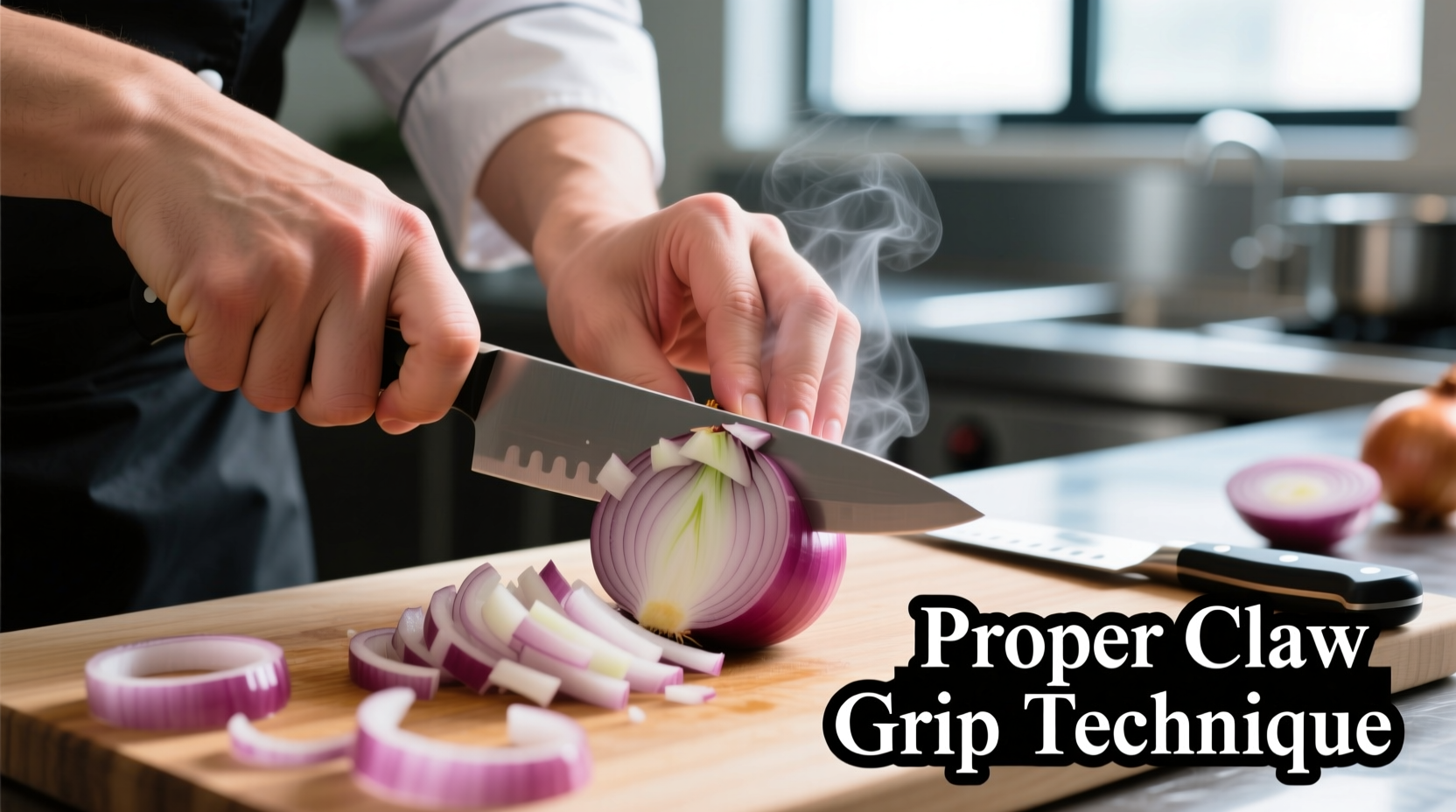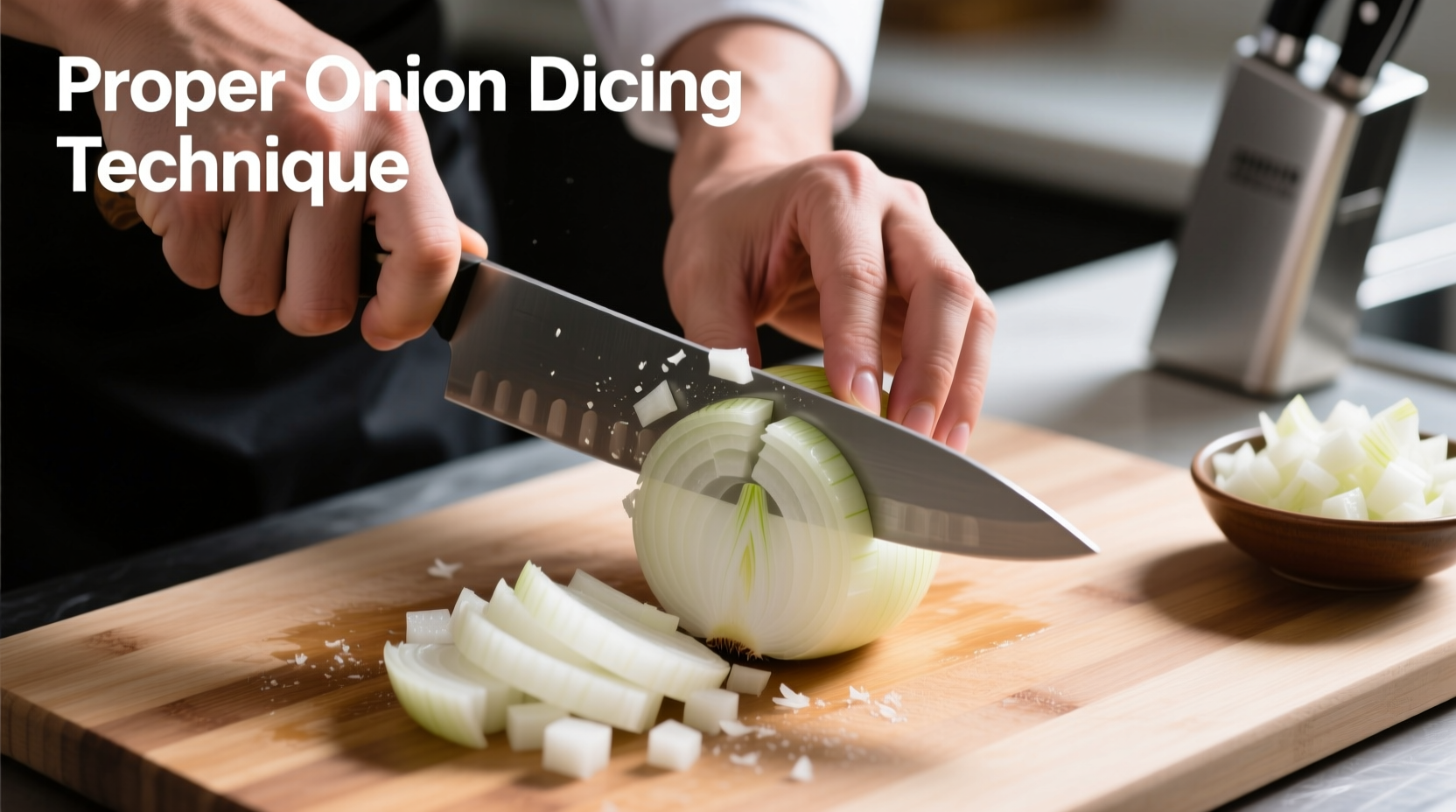Why Proper Onion Dicing Technique Matters
Unevenly diced onions create cooking disasters—some pieces burn while others remain raw. According to the USDA Food Safety and Inspection Service, consistent vegetable sizing ensures even heat distribution, critical for food safety in dishes requiring thorough cooking. Professional chefs spend years perfecting this fundamental skill because it impacts:
- Flavor development (uniform pieces caramelize evenly)
- Texture consistency in finished dishes
- Cooking time accuracy
- Visual presentation of meals
Your Onion Dicing Toolkit: What You Really Need
Forget specialty gadgets—a sharp 8-inch chef's knife and stable cutting board form the professional's toolkit. The National Institute of Food and Agriculture confirms that knife sharpness reduces cellular damage to onions, minimizing the release of lachrymatory-factor synthase (the compound causing tears). Essential elements:
| Tool | Professional Requirement | Common Mistake |
|---|---|---|
| Knife | 8-10 inch chef's knife, sharpened to 15-20 degree angle | Using serrated knives that crush cells |
| Cutting Board | Wood or composite material, weighted for stability | Slippery plastic boards causing unsafe movement |
| Hand Position | Claw grip with knuckles guiding blade | Flat palm contact risking cuts |
The 5-Step Professional Dicing Method
Follow this sequence used in culinary schools worldwide for perfect 1/4-inch dice every time:
Step 1: Strategic Trimming (The Tear-Reduction Secret)
Leave root end intact—this preserves sulfur compounds that cause tears. The Oregon State University Extension confirms that cutting through root fibers first releases maximum irritants. Trim only the stem end, preserving 1/4 inch of root structure.
Step 2: Halving and Peeling
Place onion flat-side down. Slice vertically through root end, then remove skin. Professional tip: Soak peeled halves in ice water for 30 seconds—this dissolves surface enzymes causing tears without affecting flavor.
Step 3: Creating the Foundation Slices
With cut-side down, make parallel vertical slices toward but not through the root end. Spacing determines dice size:
- 1/8 inch = fine brunoise (sauces)
- 1/4 inch = standard dice (sautés)
- 1/2 inch = large dice (stews)
Step 4: The Cross-Section Cut
Rotate onion 90 degrees. Using claw grip, slice perpendicularly through foundation cuts. Maintain consistent pressure—this creates uniform cubes. Keep root end intact until final cuts for structural stability.
Step 5: Final Release
Remove root end fragment. Gently separate cubes with fork tines. For perfect consistency, sift through fingers to remove any irregular pieces.

Troubleshooting Common Dicing Problems
Even experienced cooks encounter these issues. Here's how professionals fix them:
Problem: Uneven Cube Sizes
Solution: Check foundation slice spacing. Inconsistent vertical cuts create pyramid-shaped pieces. Use a ruler-guided approach for first 5 practice onions until muscle memory develops.
Problem: Excessive Tears
Solution: Chill onion for 30 minutes before cutting. Cold temperatures slow enzyme activity. The USDA National Agricultural Library confirms refrigeration reduces tear-inducing compounds by up to 62%.
Problem: Mushy Texture
Solution: Replace dull knives immediately. Dull blades rupture more cells, releasing enzymes that break down texture. Test sharpness by cleanly slicing paper—if it catches, sharpen immediately.
When Precision Matters: Context Boundaries
Not all dishes require perfect dice. Understanding when technique matters prevents wasted effort:
- Essential precision: French onion soup, mirepoix, salsa fresca
- Medium precision: Stir-fries, casseroles, meatloaf
- Minimal precision: Stocks, sauces where texture doesn't matter
Professional chefs adjust technique based on dish requirements—never waste time on perfect dice for stocks where onions get strained out.
Advanced Efficiency Techniques
Save 40% preparation time with these pro methods:
- The batch method: Dice multiple onions simultaneously by lining up foundation cuts across several halves
- Knife maintenance: Use ceramic rod for quick touch-ups between cuts (steel rods remove metal)
- Workspace organization: Keep ice water bowl nearby for hand rinsing between onions
Frequently Asked Questions
How do I prevent crying when dicing onions?
Chill onions for 30 minutes before cutting and leave root end intact until final cuts. The cold temperature slows enzyme release, while preserving root structure minimizes cellular damage. Professional chefs also recommend cutting under running water or wearing swim goggles for extreme sensitivity.
What's the difference between dicing and chopping onions?
Dicing creates uniform cubes of specific size (typically 1/4 inch), while chopping produces irregular pieces. Dicing ensures even cooking and texture, essential for dishes like mirepoix or salsa. Chopping works for stocks or sauces where texture doesn't matter. The knife technique differs primarily in the precision of foundation cuts.
Why do my onion dice fall apart during cooking?
This happens when using dull knives that crush rather than cut onion cells. Dull blades rupture cell walls, releasing enzymes that break down pectin structure. Always use a sharp chef's knife and avoid over-handling diced onions. For long-cooking dishes, add onions later in the process to maintain texture.
Can I use a food processor for dicing onions?
While convenient, food processors create uneven, mushy results by crushing cells rather than cutting cleanly. The blade's speed releases maximum tear-inducing compounds and destroys texture. For authentic restaurant-quality results, manual dicing with proper technique yields superior flavor development and visual appeal. Reserve processors for dishes where texture doesn't matter.











 浙公网安备
33010002000092号
浙公网安备
33010002000092号 浙B2-20120091-4
浙B2-20120091-4